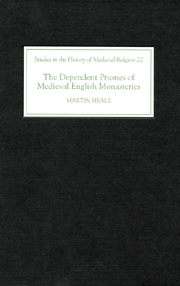Book contents
- Frontmatter
- Contents
- List of Figures and Tables
- Dedication
- Acknowledgements
- Abbreviations
- Maps: The Dependent Priories of the Monasteries of Medieval England (England and Wales)
- Introduction
- Part I The Dependent Priory as Daughter House
- Part II The Dependent Priory as Small Monastery
- 4 Monastic Life in Dependent Priories
- 5 Dependent Priories and their Neighbours
- 6 The Economy of English Cells
- Epilogue: The Dissolution of English Cells
- Appendices
- Select Bibliography
- Index
- Other Volumes in Studies in the History of Medieval Religion
6 - The Economy of English Cells
from Part II - The Dependent Priory as Small Monastery
Published online by Cambridge University Press: 12 September 2012
- Frontmatter
- Contents
- List of Figures and Tables
- Dedication
- Acknowledgements
- Abbreviations
- Maps: The Dependent Priories of the Monasteries of Medieval England (England and Wales)
- Introduction
- Part I The Dependent Priory as Daughter House
- Part II The Dependent Priory as Small Monastery
- 4 Monastic Life in Dependent Priories
- 5 Dependent Priories and their Neighbours
- 6 The Economy of English Cells
- Epilogue: The Dissolution of English Cells
- Appendices
- Select Bibliography
- Index
- Other Volumes in Studies in the History of Medieval Religion
Summary
Sources and Questions
The economic activity of dependent priories has very often been considered their primary function. Some historians have likened these small houses to granges and for others the term ‘cell’ has virtually become synonymous with bailiwick. Both comparisons, however, are misleading as far as English cells are concerned. Although a tiny dependency might superficially resemble a grange, the purely agricultural rationale of the latter is in stark contrast to the multi-faceted life of the daughter house. The bailiwick analogy is more profitable and is particularly appropriate for the mass of tiny alien priories. The classic account of such houses remains Dr Chibnall's depiction of the cells of the Norman abbey of Bec-Hellouin. From the ‘priories’ of Ogbourne, Steventon and Wilsford the canonical minimum of two Bec monks administered the abbey's scattered estates in southern England, sending back most of the annual profits from these lands as ‘apports’. As we have seen, the circumstances of the foundation of many English dependencies indicates that the management of mother-house properties was never their principal raison d‘être. Moreover, it appears that even those cells that were initially founded by an abbey to overcome the problems of administering distant estates, such as St Nicholas' Exeter, often soon acquired a religious momentum of their own.
By the late thirteenth century, when relevant documentation first survives, very few English dependencies were sending back a sizeable apport.
- Type
- Chapter
- Information
- The Dependent Priories of Medieval English Monasteries , pp. 229 - 276Publisher: Boydell & BrewerPrint publication year: 2004

